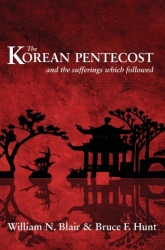Odds are you have never heard of the “Korean Pentecost” – the powerful workings of the Spirit of God in sweeping many Koreans into the Kingdom of Christ in the early 20th century and the faithful persecution and even martyrdom of many believers that followed, particularly in the North.
The gospel first landed in Korea in 1832 with the arrival of missionary Charles Gutzlaff – a friend of Robert Morrison, the first Protestant missionary to China – under the auspices of the East India Company. The gospel seed then sown came to revival proportions in the early half of the 20th century.
This fascinating account was a joint effort. William N. Blair (1876-1970), in his first term of missionary service, was at the center of the great revival of 1907, and his account of this and the events leading up to it forms the first part of the book. Blair includes a thrilling description of how the gospel first came to Korea. This account is taken up by his son-in-law, Bruce Hunt (1903-1992) – born in Pyengyang, now the capital of North Korea – who shows how the revival was followed by a baptism of suffering under the Japanese and Communists. During his forty-eight years of missionary service in Korea, Hunt personally knew many of the Korean Christian martyrs.
This from the Epilogue:
During the period recorded in the two parts of this book the Protestant Church in Korea has grown from the first believer, baptized in 1886, just ninety years ago, to the present 2,689,918 members worshipping in 1,304 churches throughout South Korea. [There is no data regarding the church in the North.] This growth, in other words, has taken place during the lifetime of some people, Koreans as well as Westerners, who are still living today [1977].
Since the baptism of that first Christian, ninety years ago, the Korean Church has survived five wars. During this time the country has constantly seen foreign troops on her soil or has been actually occupied in part or in whole by foreign nations, and now, finally, is governed by opposing political regimes.
Today the country is divided, not by the choice of the majority of the Korean people, but as the result of an agreement between the leaders of China, Russia, Great Britain and the United States at Yalta, before the end of the Second World War. As a result of this agreement, since 1945 an atheistic Communist government has been ruling that half of the country north of the 38th parallel. It was in this northern half of the country that the church originally began and grew strongest. It is the area in which most of the incidents recorded in both parts of this book took place.
After the Communists came into power in the northern half of Korea, thousands of Christians in that area, especially Christian ministers, church officers and leaders, were killed by them. During the Korean War, when the Communist armies overran all but the 50-mile Pusan perimeter, many Christians in South Korea were also killed by the Communist forces.
Before the ‘bamboo curtain’ became an ‘iron wall’, at the end of the Korean War, many thousands of Christians were able to escape south with the masses moving to flee from Communism, and contributed to the phenomenal population increase in the southern part of Korea of which we hear so much today.
Statistics and information about the church in the northern half of the country, where the revival took place, are not available today.
But we know that the story is not finished and will not be until Jesus comes.
This is a deeply moving account of an often overlooked chapter of Christian history. Highly recommended for every church library.
Fred G. Zaspel
Buy the books

The Korean Pentecost And The Sufferings Which Followed